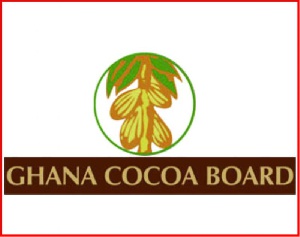 COCOBOD is exploring prospects in the Chinese market for the country
COCOBOD is exploring prospects in the Chinese market for the country
Ghana Cocoa Board (Cocobod) is vigorously exploring prospects in the Chinese market for the country’s premium cocoa products, for which reason meetings have been ongoing between the two sides.
Cocobod also plans to make a good showing at the maiden China International Import Exposition to be held in Shanghai from November 5, 2018 to November 10, 2018.
“A team from the Cocobod has already met officials at the Chinese Embassy; we have, again, met in Accra and our officers have started putting things together and it is because Cocobod wants to enter and explore the huge Chinese market for the cocoa products,” Noah Kwesi Amenyah, Cocobod’s Public Affairs Manager, told the B&FT.
“We want to send into that market value added cocoa products and not just raw beans; it will be good for us to get the Chinese public to know that Ghana’s cocoa is the best and it has a lot of nutritional and health benefits and therefore they have to patronise it,” he said.
Although China’s individual chocolate consumption is considered still low, less than 5% of what major lovers munch in the west, market research firm Ebrun reports that the market for chocolate in China is expected to grow in value to 40 billion yuan (US$6.2 billion) by 2020.
Ghana’s main export destinations are the Netherlands, with a market share of 12.88%, France 11.6% and USA 10.9%.
France and USA grew significantly during 2012-2016. Exports to France, especially, reached high growth rates. With an average annual growth of +23% over 2012-2016, the country became the second largest Ghanaian export destination.
Exports to Spain and Belgium remained quite stable during 2012-2016, with export values between US$5-40 million.
Total exports of cocoa products from Ghana amounted US$542 million in 2016.
Exports to the Dutch market dropped from US$205 million in 2012 to only US$70 million in 2016, a decrease of-24% on average per year.
Ghana’s exports to China, on the other hand, is dominated by traditional or primary exports, such as unprocessed cocoa, raw metals, wood products, and petroleum oils, which account for 96 per cent of exports to the Asian nation, statistics from the Ministry of Trade show.
China International Import Expo
The China International Exposition is expected to attract over 100 countries and regions with various products. It is also expected that thousands of enterprises from these countries will attend the event, bringing up to a million commodities and services to the Chinese market.
China is therefore inviting Ghanaian manufacturers to enter its vast market to exhibit their products and to take advantage of the opportunity.
At a joint media briefing, Mr. Chai Zhijing, Economic and Commercial Counselor at the Chinese Embassy, explained that the exhibition is an opportunity for local business owners to woo foreign investors into Ghana.
He said: “At the moment, as far as biological trade is concerned, Ghana is one of our top 10 trading partners in Africa.
But at the moment, Ghana’s trade with China is in a deficit. So, that means that Ghana buys more from China than it exports,” Mr.Zhijing said.
“So, I think this Import Expo will be a very good opportunity for Ghana to show its potential – what it can offer to the Chinese consumers,” he added.
Deputy Trades Minister, Carlos Ahenkorah, confirmed government’s commitment to supporting local manufacturers and business owners in this regard, adding that the ministry is considering a proposal to acquire a pavilion in China to aid Ghanaian exhibitors.
“We want to take advantage of the early bird offer and have a whole pavilion to ourselves outside the individual enterprises that are going to have their own,” he said.
“If our request is accepted; if our one-month moratorium is given, I can assure you that within the month of February we would be able to affirm our commitment to take a pavilion for Ghana in the expo,” he stated.
Over the past decade, China’s annual growth rate of retail sales have stayed above 10%. While Chinese consumers are now starting to value quality over price, imported goods are gaining popularity.
In the past, importing market was dominated by large overseas companies. Nowadays, small and medium-sized businesses are selling huge amounts of products into China via new channels, such as shopping agents, supermarkets, and E-commerce.
China’s food and agricultural imports keep growing in recent years. In 2016, total import of food reached US$50 billion, and import of agricultural products were more than $110 billion.